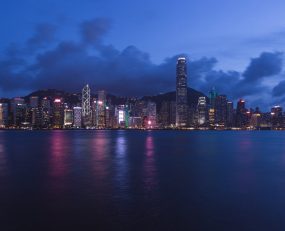
It was a difficult year for Hong Kong, whose economy struggled in 2019 not only because of US-China trade tensions, but also due to the protests and disruptions which have been ongoing since June and have hindered private consumption, exports, freight movement and investments in industrial properties.
According to the International Monetary Fund, in 2019 the Hong Kong economy is expected to contract by around 1.9%. About two thirds of the 2.9% July-September year-on-year decline was attributable to the protests, according to the Financial Secretary Paul Chan. The month of November represented the 12th month of export decline in a row, with a 5.8% decrease year-on-year. Retail sales experienced their sharpest fall on record in October 2019 by 23.4% year-on-year, according to Asia Times. By August 2019, around 100 out of 1,027 shops in the Hong Kong Causeway Bay shopping district closed.
The decline in the economy generated, unsurprisingly, further challenges in Hong Kong’s logistics activities. It saw a decrease in air freight cargo throughput and warehouse investments in the region.
As reported by the Hong Kong’s Civil Aviation Authority, statistics show that air freight throughput has decreased on a monthly basis since April 2019. On a rolling 12-month basis as of October 2019, cargo throughput dropped 6.4% to 4.8m tonnes, according to airport figures. Making the situation worse, protestors also targeted the access to main transport routes, including highways to and from the airport, further impacting the ability of cargo carriers to get freight to and from the airport.
Prior to that, in August, sit-in demonstrations had caused Hong Kong International Airport to be shut down for two consecutive days, causing the cancellation of around 300 flights. Cargo carriers that reported disruptions included the likes of Yangtze River Express, China Cargo Airlines, UPS, Airbridge Cargo Airline and SpiceJet.
Because of the difficulties in freight transport, as well as the reduction of domestic consumption and the overall sentiment of uncertainty caused by the disruptions, LSPs have been viewing Hong Kong as a challenging market and appetite for industrial properties investment fell 52% in Q3 2019 year-over-year, according to a report from the South China Morning Post.
Despite that, as of mid-December 2019 vacancy rates in Hong Kong’s warehousing stock totalled 1.7% of its 2m sq ft supply, which according to the South China Morning Post is the lowest vacancy rate the region has seen for the past five years. The real problem is represented by future investments in industrial properties. Looking at November 2019 figures, such investments amounted to just $2.7bn, while, for the whole of 2018, it totalled more than $5.9bn, therefore it is unlikely that end-of-year figures will match the 2018 ones. Furthermore, currently, only one new logistics site has been announced. Located in Tuen Mun Town and purchased by an investment fund managed by Goodman Group, it is expected that the facility will function starting from 2021 and will provide warehouse space of about 1.6m sq ft.
Government regulations favouring buildings for commercial or residential use over the construction of new facilities coupled with the reticence in investing due to the turmoil, could limit future availability of inventory storage space. With stores closing down at a fast pace, and luxury brands such as Chanel or Louis Vitton either refraining from opening new shops or closing them due to plummeting sales, future investments from developers in storage space are unlikely to pick up on the short run, at least in some verticals.
January 2020 has not seen the cease of the protests and the outlook on the new year is grim. According to Capital Economics “recovery will be constrained by weak business investment as the city’s political crisis has done lasting damage to its reputation as a stable and autonomous financial hub”. Currently, thus, Asia’s other hubs such as Singapore might represent, instead, a more tempting opportunity for logistics activities.
Source: Transport Intelligence, January 7, 2020
Author: Caterina Ciccone